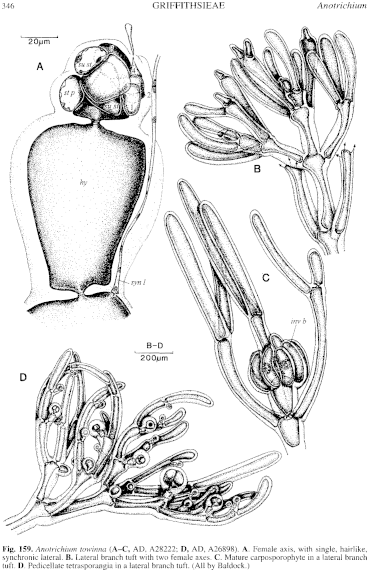|
|
|
|
|
|||||||||||
|
Electronic Flora of South Australia Species Fact Sheet
Phylum Rhodophyta – Order Ceramiales – Family Ceramiaceae – Tribe Griffithsieae
Thallus (Fig. 157B) light or dark red, 3–5 cm high, with several irregular main axes bearing whorls of 3 (–4) divergent lateral branch tufts of restricted growth from most axial cells. Attached by rhizoids from the thallus base; epiphytic. Structure. Axial cells elongate, 150–180 µm in diameter and L/D 3–10, branching (Fig. 159C) initially subdichotomous by oblique divisions of the subapical cell, rapidly adventitiously tri- or tetrachotomous with one of the branches developing into an indeterminate axis, the remaining branches forming short lateral tufts (Fig. 157C) branched trichotomously and divergently 5–6 times, basal cells 70–100 µm in diameter and L/D 5–8, apical and sub apical cells elongate, 68–80 µm in diameter and L/D 5–9, filaments ending obtusely or umbonately (Fig. 159B), apical cells often campanulate, 45–55 µm in diameter and notably narrower than subapical cells; branches bearing carposporophytes and tetrasporangia (Fig. 159B–D) less divergent. Rhodoplasts discoid, numerous, or elongate and net-like, with small refringent inclusions; large crystals sometimes present in the cytoplasm.
Reproduction: Female axes 3-celled, initially subterminal in lateral branch tufts (Fig. 159B) flanked by 1 (–2) elongate, unbranched, caducous, colourless hair-like synchronous laterals; procarp systems (Fig. 159A) subapical, each with an abaxial, sterile lateral and adaxially a supporting cell bearing apically a sterile cell and a recurved, 4-celled carpogonial branch laterally; hypogenous cell enlarging, becoming pyriform, 80–210 µm in diameter and L/D 1–1.2 and producing from its upper shoulder a whorl of 10–12 incurved, reniform, 1-celled synchronic involucral cells 80–120 µm in diameter and L/D 1.8–2; fusion cell columnar, bearing 1–3 gonimolobes apically, most cells of which become ovoid-clavate carposporangia, 35–45 µm in diameter; vegetative growth inhibited by maturing carposporophytes which lie in axils near the ends of lateral tufts (Fig. 159C). Spermatangia unknown.
Tetrasporangia (Fig. 159D) single on solitary pedicels 40–45 µm in diameter, produced adaxially towards the apices of lateral tufts, initially in the position of a subdichotomous branch, but some later flanked by the development of 1 (–3) further vegetative branches, thus appearing axillary; globose, 90–150 µm in diameter, tetrahedrally divided.
Type from Saunders Beach, Kangaroo I., S. Aust. (Womersley, 29.ix.1964), holotype and isotype in AD, A28222.
Selected specimens: Coffin Bay, S. Aust., 3–4m deep (Womersley, 4.xii.1975; AD, A46928) and in Posidonia bed, 2.5m deep, (Womersley, 4.xii.1975; AD, A46939). American R. inlet, Kangaroo I., S. Aust., 2–4 m deep (Womersley, 22.viii.1963; AD, A26898).
Distribution: Coffin Bay and Kangaroo I., S. Australia.
Taxonomic notes: Named for the Australian Aboriginal Kaurna word meaning "outstretched", referring to the divergent branching of lateral tufts, obvious in pressed specimens.
Millar (1986, p. 87) described Baldockia verticillata Millar from Coffs Harbour, N.S.W., which is superficially similar to A. towinna in its adventitious sub-trichotomous branching. However, Baldockia also subsequently initiates 7 pigmented, robust synchronic branchlets from axial nodes, and also produces a unique sequence of female fertile axes, allying it to Halurus.
Calliclavula trifurcata Schneider from Grays Reef, Georgia USA (Searles & Schneider 1989, p. 732) produces whorls of 3 branchlets consisting of large, clavate cells branched subdichotomously; however, unlike the lateral tufts of restricted growth in A. towinna, these are indeterminate and are preceded by the development of subapical whorls of 2–4 slender, pigmented laterals, features which separate it from the genus Anotrichium.
References:
MILLAR, A.J.K. (1986). Baldockia verticillata (Griffithsieae, Ceramiales), a new red algal genus and species from eastern Australia. Phycologia 25(1), 87–97.
SEARLES, R.B. & SCHNEIDER, C.W. (1989). New genera and species of Ceramiaceae (Rhodophyta) from the southeastern United States. J. Phycol. 25, 731–740.
The Marine Benthic Flora of Southern Australia Part IIIC complete list of references.
Publication:
Womersley, H.B.S. (24 December, 1998)
The Marine Benthic Flora of Southern Australia
Rhodophyta. Part IIIC. Ceramiales – Ceramiaceae, Dasyaceae
©State Herbarium of South Australia, Government of South Australia
Illustrations in Womersley Part IIIA, 1998: FIGS 157B, C, 159 A–D.

Figure 157 enlarge
Fig. 157. A. Anotrichium tenue var. thyrsigerum (AD, A26364). Habit. B, C. Anotrichium towinna (AD, A28222). B. Habit. C. Detail of main axes and whorls of laterals with divergent branches. D, E. Anotrichium subtile (AD, A32281). D. Habit. E. Spermatangial head.

Figure 159 enlarge
Fig. 159. Anotrichium towinna (A–C, AD, A28222; D, AD, A26898). A. Female axis, with single, hairlike, synchronic lateral. B. Lateral branch tuft with two female axes. C. Mature carposporophyte in a lateral branch tuft. D. Pedicellate tetrasporangia in a lateral branch tuft. (All by Baldock.)

|
Email Contact: State Herbarium of South Australia |

|